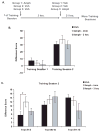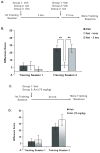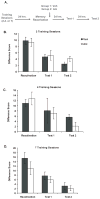Post-training, but not post-reactivation, administration of amphetamine and anisomycin modulates Pavlovian conditioned approach
- PMID: 17258476
- PMCID: PMC1896137
- DOI: 10.1016/j.nlm.2006.12.007
Post-training, but not post-reactivation, administration of amphetamine and anisomycin modulates Pavlovian conditioned approach
Abstract
The psychostimulant, amphetamine (AMPH), and the protein synthesis inhibitor, anisomycin (ANI), have been shown to modulate the consolidation and reconsolidation of several types of learning. To determine whether Pavlovian conditioned approach (PCA) is modulated in a similar manner, we examined the effects of post-training and post-reactivation administration of both AMPH and ANI on memory for PCA. Male Long-Evans rats received PCA training sessions during which presentations of a CS+ were followed by sucrose delivery. AMPH (1 mg/kg, s.c.) injected immediately but not 6h after the first training session enhanced PCA behavior. ANI (150 mg/kg, s.c.) injected immediately but not 3h after the first training session impaired PCA behavior. This impairment was not due to the development of a conditioned taste aversion. To examine whether PCA can also be modulated by post-reactivation administration of AMPH and ANI, rats were given an injection of AMPH, ANI, or vehicle immediately after a memory reactivation session. Upon testing, the behavior of both the AMPH- and the ANI-treated rats was unaffected. This result remained consistent when the experiment was repeated with changes to various behavioral parameters (i.e., amount of training, length of memory reactivation). These findings indicate that AMPH and ANI act during the post-training but not the post-reactivation period to enhance and impair, respectively, the learning of PCA. This suggests that the consolidation of PCA can be modulated in a manner comparable to other types of learned associations, but once learned, the memory appears to be relatively robust and stable.
Figures







References
-
- Abel T, Lattal KM. Molecular mechanisms of memory acquisition, consolidation, and retrieval. Current Opinion in Neurobiology. 2001;11:180–187. - PubMed
-
- Alberini CM. Mechanisms of memory stablization: are consolidation and reconsolidation similar or distinct processes? Trends in Neurosciences. 2005;28:51–56. - PubMed
-
- Bahar A, Dorfman N, Dudai Y. Amygdalar circuits required for either consolidation or extinction of taste aversion memory are not required for reconsolidation. European Journal of Neuroscience. 2004;19:1115–1118. - PubMed
-
- Berman DE, Dudai Y. Memory extinction, learning anew, and learning the new: dissociations in the molecular machinery of learning in cortex. Science. 2001;291:2417–2419. - PubMed
-
- Biedenkapp JC, Rudy JW. Context memories and reactivation: constraints on the reconsolidation hypothesis. Behavioral Neuroscience. 2004;118:956–964. - PubMed
Publication types
MeSH terms
Substances
Grants and funding
LinkOut - more resources
Full Text Sources

